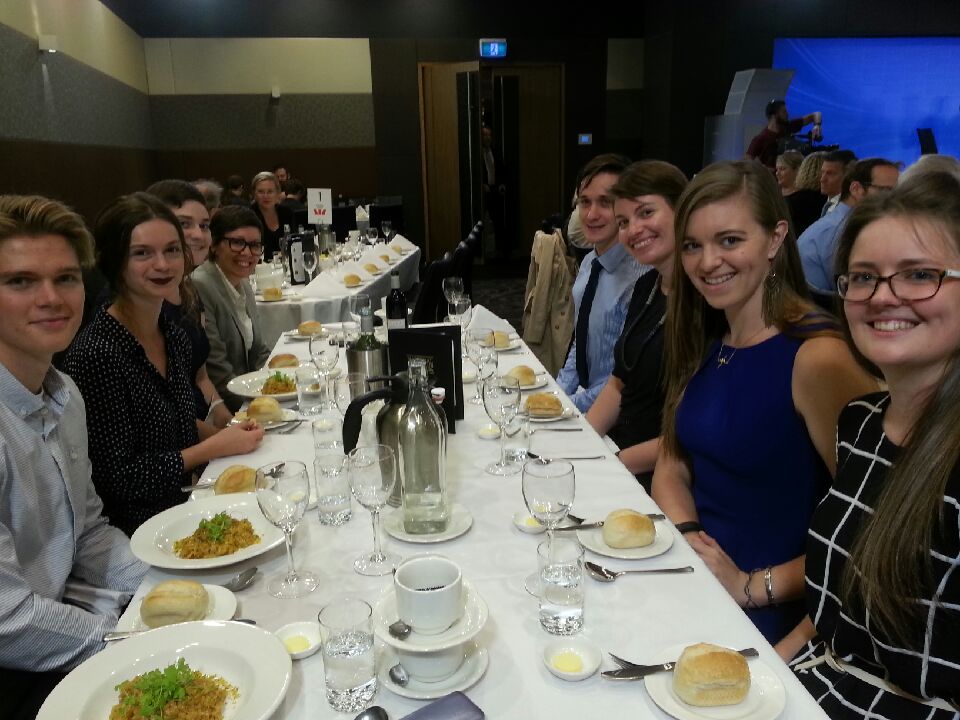By Kate O’Sullivan
Tanya Monro, Emma Johnston and Nalini Joshi have one very important thing in common. All three are scientists in senior positions in their respective fields. And all three of them took to the stage at the National Press Club in Canberra, in March, to discuss a topic near and dear to all of them – the importance of having women working in science.
Along with some fellow NYSF Alumni, I was very fortunate to attend. I say fortunate because what was to follow was the telling of some of the most interesting stories of women in STEM fields, the barriers they have come up against, and the steps we can take to try and overcome them.

NYSF at the National Press Club
Left- Brody, Ruth, Brittany & Julie Right - Melanie, Kate, Madeline & Patrick
Professor Tanya Monro, NYSF Chair and Deputy Vice Chancellor Research and Innovation at the University of South Australia, shared her story that highlights the implicit biases against women in research. Professor Monro was turned down for one of the PhD projects she applied for because the prospective supervisor did not think she was the type of student that could thrive in physics research - this was prior to her supervisor seeing her resume or academic credentials. This is a woman who went on to be the first-ever female professor of physics at the University of Adelaide.
Emma Johnston is a Professor of Marine Ecology and Ecotoxicology at the University of New South Wales and Director of the Sydney Harbour Research Program at the Sydney Institute of Marine Science. She told the story of her parents – both with aspirations of careers in science. Her father became a Dean of Engineering with her mother working for a couple of years and then never returning to science after having and raising children because of highly gendered structural barriers and cultural expectations at that time. According to “the system”, Professor Johnson recounts that she “did everything wrong”, from dropping physics and mathematics at university because of the lack of female lecturers and students, to not applying for PhDs or postdoctoral opportunities, but going into teaching instead.
Professor Nalini Joshi, is the first female professor of mathematics at the University of Sydney and an ARC Georgina Sweet Australian Laureate Fellow. She recounted an experience of “being mistaken for the serving staff” at social and networking events.
These women are prime examples of what women can do in science – but we often don’t hear their stories because of biases and barriers to women’s progression in the scientific fields. The subtle push of women out of research is not for females’ lack of interest in STEM areas – rather it is due to institutional, endemic and unseen biases. Nalini Joshi said, “Australia is frozen in time.” The field is competitive and the selection policies for roles tend to self-select women out. As Emma Johnson put it - Why does the system shoot itself in the foot?
These explicit biases have been discussed widely – the motherhood penalty being one of the most commonly mentioned. But the hidden biases are ‘slipperier’ and harder to define. To quote from the discussion – the “under-representation of women in science is only one of the barriers that faces the increasing progress of women.”
Tanya Monro reported that when she had her first child, she found the experience focused her mind more than anything. While at work, she wanted to be there and achieve everything she possibly could because, “why else was he [her son] in childcare?” What made this possible were advocates and mentors. Her boss allowed for a four day week to count as a full time load, empowering her to succeed and feel valued in the workplace.
The three speakers offered the following suggestions to address the issues currently faced by women in STEM:
- Quotas and Targets
Although these often cause fear of appointment based on things other than merit, the panel in general agreed that targets, if not quotas should be implemented. They have been shown to work, and to make the definition of merit more equitable in the future. A change in the number of women in an organisation can help shift the culture to better include women. - Role models and the idea of critical mass
In the words of Emma Johnston “When there are fewer women in a room full of scientists, women are acutely aware of their gender. When there is a critical mass, it becomes a discussion of ideas,” she said. - The SAGE initiative
The Australian Academy of Science has adapted this from the Athena Swan program in the UK to eliminate gender inequity and a demonstrated commitment to bolster the hiring, promotion and retention of women, while also improving the workplace environment for people of all genders.
But one quote summed up the entire event for me. “STEM can transform people.” And that is something we need to hold onto – no matter who you are, studying and working in STEM fields can transform a life. We need to make that transformation accessible for everyone. This is much more than getting girls into the science pipeline and into our labs. It’s about making sure that our society can benefit from an education that is rich in science. Until we are all able to pursue our passions (no matter how ‘untrendy’), we have lost the game. Because, as Tanya Munro put it, “we don’t want our daughters to have fewer choices than our sons.”
Watch the discussion on ABC News – or read the speech transcripts.
Reference
Other interesting facts about the proportions of Women in STEM can be found at:
- Australian Academy of Science on gender equity - https://www.science.org.au/supporting-science/gender-equity
- Chief Scientists office on Australia’s STEM workforce - http://www.chiefscientist.gov.au/2016/03/report-australias-stem-workforce/